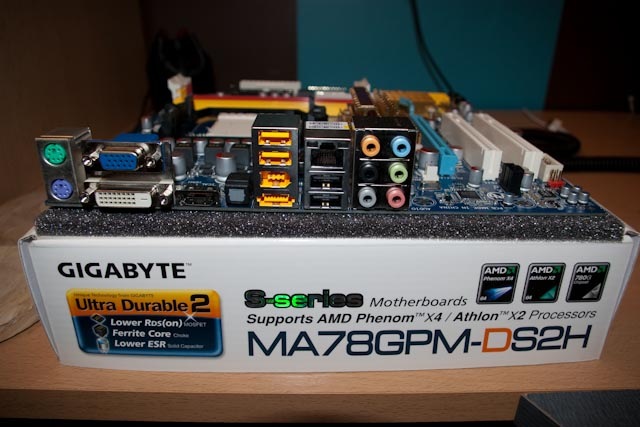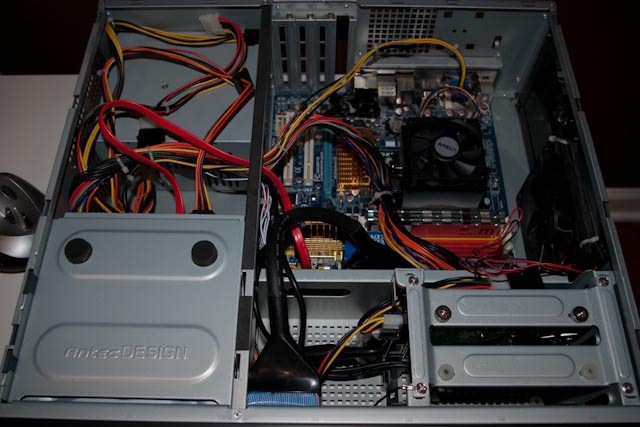I recently turned on the TV to see my home theater PC frozen and a nasty buzzing sound coming from the speakers. Long story short, eventually I figured that my motherboard had gone bad (and not surprisingly too, as the system was my old main computer that I built almost 6 years ago and had an AMD Athlon XP single-core processor, etc). I can’t say I wasn’t expecting this sometime.
The skeleton of the system is still fairly modern, and the case looks good in the living room alongside the receiver, so I figured I could try to replace the guts. Since this computer is mainly used for playing video from a shared media folder or streamed from the web, I didn't need the most up-to-date hardware, and I wanted to find a motherboard with a lot of capabilities onboard that was fairly inexpensive. Additionally, I wanted the system to be quiet and low-power, as the old system, while not terribly annoying, was a little louder than most electronics you find in a living room.
Luckily for me, Coding Horror had a great piece on building something very similar to what I wanted that was posted last April. The hardware I went with was slightly updated from what Jeff used, but essentially the same:
| CPU | AMD Athlon X2 4850e 2.5GHz Dual Core (45w) | $60 |
| Motherboard | GIGABYTE GA-MA78GPM-DS2H | $100 |
| RAM | 2 x 1 GB Mushkin DDR2 800 Mhz EM2-6400 | $10 |
| Blu-ray Drive | LG 6X Blu-ray DVD±R DVD Burner | $115 |
* I used my existing parts for the remainder.
The specs and reviews of the motherboard surprised me; I read it was capable of decoding Blu-ray video very smoothly with its miniscule (by today’s standards) 128 MB of on-board video memory. This being said, and even though bare Blu-ray drives are numerous, they’ve come down in price, and Netflix has a growing catalog of Blu-ray discs, I still think getting a Blu-ray drive may have been unnecessary, but I caved in to the appeal of the bright and shiny.
Ports!
Also, the processor is a fairly powerful dual-core one yet only uses 45W of power. Given this, the stock heat-sink and fan that’s included with the processor is supposed to suffice while being fairly quiet. The CPU’s fan speeds up as the processor temperature rises, and in my testing I never heard it kick into a higher gear.
Putting it all together in the Antec HTPC case
Resolution
The biggest problem I ran into was getting the proper resolution driven to the TV. The TV (a 46” Sony LCD), is capable of displaying up to 1920x1080 (1080p), and my old system would show this resolution in Windows for me to select. For some reason, the new system and video card would only let me select up to 1600x1200 using a VGA cable, and, after experimenting with different drivers, an HDMI cable (which would display the desired resolution but looked fuzzy), and ATI’s Catalyst display software, I eventually settled on using PowerStrip to force 1920x1080 through the VGA cable. The results are good, and the picture is comparable in sharpness to a computer monitor.
Testing
I tested playing several HD 1080p sample videos with good results. In informal testing, overall CPU utilization stayed around 40-50% when playing full screen 1920x1080 video.
I added Blu-ray access to my Netflix account (for an additional $1), and got my first Blu-ray disc in today (Burn After Reading). I needed to use PowerDVD to play the film (included with the drive), but the video was beautifully smooth.
The finished setup (receiver on the left, PC on the right)
Windows 7 and Windows Media Center
I also did all of this testing using Windows 7 Beta 64-bit edition, and I didn’t experience any major stumbling blocks. Where applicable, I chose the Vista 64 version of software, and only encountered a few glitches (such as preferences not taking effect immediately or general UI bugs).
Windows 7 Beta Ultimate edition includes Windows Media Center, and I tested using it to access shared video on my home network and some internet TV “channels” that are set up by default in the app, but since I don’t have cable TV and and don’t use Windows Media Center as a Tivo, I could manage (as I’ve been doing), by picking shared network video files from Windows explorer or by watching content on ABC.com, Hulu, etc.
Boxee
I also tried the alpha version of Boxee for Windows, but the display was distorted badly when the program started and it was unusable (driver? Windows 7 incompatibility?). I’ll have to see if there’s a workaround for this and look out for a beta version of it.


